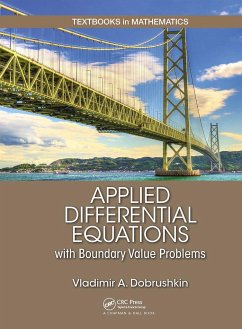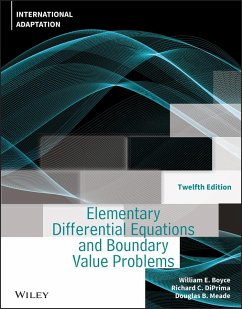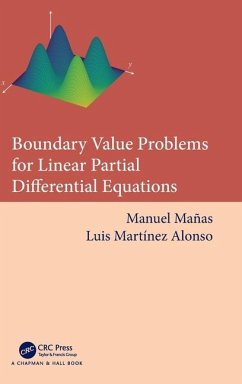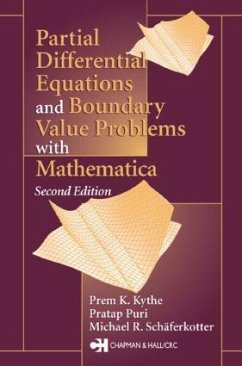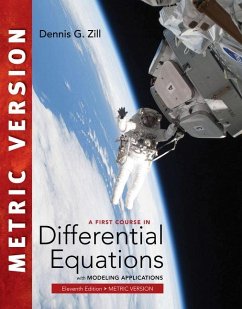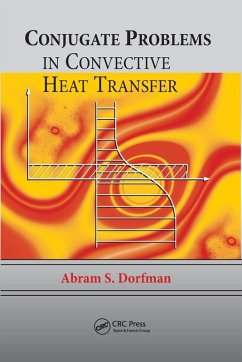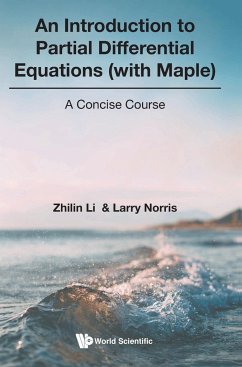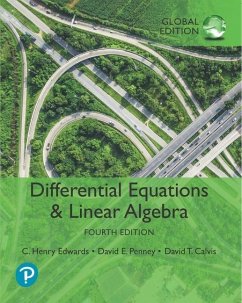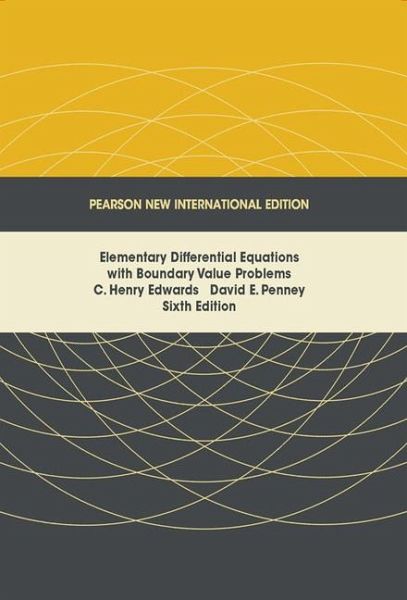
Elementary Differential Equations with Boundary Value Problems
Pearson New International Edition
Versandkostenfrei!
Versandfertig in 2-4 Wochen
123,99 €
inkl. MwSt.

PAYBACK Punkte
62 °P sammeln!
For briefer traditional courses in elementary differential equations that science, engineering, and mathematics students take following calculus.
The Sixth Edition of this widely adopted book remains the same classic differential equations text it's always been, but has been polished and sharpened to serve both instructors and students even more effectively.Edwards and Penney teach students to first solve those differential equations that have the most frequent and interesting applications. Precise and clear-cut statements of fundamental existence and uniqueness theorems allow understanding of their role in this subject. A strong numerical approach emphasizes that the effective and reliable use of numerical methods often requires preliminary analysis using standard elementary techniques.
Features + Benefits
• Proven chapter and section structure of the book is unchanged – Instructors' notes and syllabi will not require revision to continue teaching with the Sixth Edition.
• A solid numerical emphasis – Includes generic numerical algorithms and a limited number of illustrative graphic calculator, BASIC, and MATLAB routines.
• Wide range of choices regarding breadth and depth of coverage – The first few sections of most chapters introduce the principal ideas of each topic, with remaining sections devoted to extensions and applications.
• Computer-generated figures – Includes graphics using Mathematica or MATLAB; shows students vivid pictures of direction fields, solution curves, and phase plane portraits that bring symbolic solutions of differential equations to life.
• Application Modules – Follow appropriate sections in the book; give students concrete applied emphasis and engages them in more extensive investigations than in typical exercises and problems.
• Instructor's Solutions Manual – Provides worked-out solutions for most of the problems in the book.
• Student Solutions Manual – Contains solutions for most of the odd-numbered problems.
Preface
1 First-Order Differential Equations
1.1 Differential Equations and Mathematical Models
1.2 Integrals as General and Particular Solutions
1.3 Slope Fields and Solution Curves
1.4 Separable Equations and Applications
1.5 Linear First-Order Equations
1.6 Substitution Methods and Exact Equations
1.7 Population Models
1.8 Acceleration-Velocity Models
2 Linear Equations of Higher Order
2.1 Introduction: Second-Order Linear Equations
2.2 General Solutions of Linear Equations
2.3 Homogeneous Equations with Constant Coefficients
2.4 Mechanical Vibrations
2.5 Nonhomogeneous Equations and Undetermined Coefficients
2.6 Forced Oscillations and Resonance
2.7 Electrical Circuits
2.8 Endpoint Problems and Eigenvalues
3 Power Series Methods
3.1 Introduction and Review of Power Series
3.2 Series Solutions Near Ordinary Points
3.3 Regular Singular Points
3.4 Method of Frobenius: The Exceptional Cases
3.5 Bessel's Equation
3.6 Applications of Bessel Functions
4 LaplaceTransform Methods
4.1 Laplace Transforms and Inverse Transforms
4.2 Transformation of Initial Value Problems
4.3 Translation and Partial Fractions
4.4 Derivatives, Integrals, and Products of Transforms
4.5 Periodic and Piecewise Continuous Input Functions
4.6 Impulses and Delta Functions
5 Linear Systems of Differential Equations
5.1 First-Order Systems and Applications
5.2 The Method of Elimination
5.3 Matrices and Linear Systems
5.4 The Eigenvalue Method for Homogeneous Systems
5.5 Second-Order Systems and Mechanical Applications
5.6 Multiple Eigenvalue Solutions
5.7 Matrix Exponentials and Linear Systems
5.8 Nonhomogeneous Linear Systems
6 Numerical Methods
6.1 Numerical Approximation: Euler's Method
6.2 A Closer Look at the Euler Method
6.3 The Runge-Kutta Method
6.4 Numerical Methods for Systems
7 Nonlinear Systems and Phenomena
7.1 Equilibrium Solutions and Stability
7.2 Stability and the Phase Plane
7.3 Linear and Almost Linear Systems
7.4 Ecological Models: Predators and Competitors
7.5 Nonlinear Mechanical Systems
7.6 Chaos in Dynamical Systems
8 Eigenvalues and Boundary Value Problems
8.1 Sturm-Liouville Problems and Eigenfunction Expansions
8.2 Applications of Eigenfunction Series
8.3 Steady Periodic Solutions and Natural Frequencies
8.4 Cylindrical Coordinate Problems
8.5 Higher-Dimensional Phenomena
9 Fourier Series Methods
9.1 Periodic Functions and Trigonometric Series
9.2 General Fourier Series and Convergence
9.3 Fourier Sine and Cosine Series
9.4 Applications of Fourier Series
9.5 Heat Conduction and Separation of Variables
9.6 Vibrating Strings and the One-Dimensional Wave Equation
9.7 Steady-State Temperature and Laplace's Equation
Appendix: Existence and Uniqueness of Solutions
Answers to Selected Problems
Index I-1
The Sixth Edition of this widely adopted book remains the same classic differential equations text it's always been, but has been polished and sharpened to serve both instructors and students even more effectively.Edwards and Penney teach students to first solve those differential equations that have the most frequent and interesting applications. Precise and clear-cut statements of fundamental existence and uniqueness theorems allow understanding of their role in this subject. A strong numerical approach emphasizes that the effective and reliable use of numerical methods often requires preliminary analysis using standard elementary techniques.
Features + Benefits
• Proven chapter and section structure of the book is unchanged – Instructors' notes and syllabi will not require revision to continue teaching with the Sixth Edition.
• A solid numerical emphasis – Includes generic numerical algorithms and a limited number of illustrative graphic calculator, BASIC, and MATLAB routines.
• Wide range of choices regarding breadth and depth of coverage – The first few sections of most chapters introduce the principal ideas of each topic, with remaining sections devoted to extensions and applications.
• Computer-generated figures – Includes graphics using Mathematica or MATLAB; shows students vivid pictures of direction fields, solution curves, and phase plane portraits that bring symbolic solutions of differential equations to life.
• Application Modules – Follow appropriate sections in the book; give students concrete applied emphasis and engages them in more extensive investigations than in typical exercises and problems.
• Instructor's Solutions Manual – Provides worked-out solutions for most of the problems in the book.
• Student Solutions Manual – Contains solutions for most of the odd-numbered problems.
Preface
1 First-Order Differential Equations
1.1 Differential Equations and Mathematical Models
1.2 Integrals as General and Particular Solutions
1.3 Slope Fields and Solution Curves
1.4 Separable Equations and Applications
1.5 Linear First-Order Equations
1.6 Substitution Methods and Exact Equations
1.7 Population Models
1.8 Acceleration-Velocity Models
2 Linear Equations of Higher Order
2.1 Introduction: Second-Order Linear Equations
2.2 General Solutions of Linear Equations
2.3 Homogeneous Equations with Constant Coefficients
2.4 Mechanical Vibrations
2.5 Nonhomogeneous Equations and Undetermined Coefficients
2.6 Forced Oscillations and Resonance
2.7 Electrical Circuits
2.8 Endpoint Problems and Eigenvalues
3 Power Series Methods
3.1 Introduction and Review of Power Series
3.2 Series Solutions Near Ordinary Points
3.3 Regular Singular Points
3.4 Method of Frobenius: The Exceptional Cases
3.5 Bessel's Equation
3.6 Applications of Bessel Functions
4 LaplaceTransform Methods
4.1 Laplace Transforms and Inverse Transforms
4.2 Transformation of Initial Value Problems
4.3 Translation and Partial Fractions
4.4 Derivatives, Integrals, and Products of Transforms
4.5 Periodic and Piecewise Continuous Input Functions
4.6 Impulses and Delta Functions
5 Linear Systems of Differential Equations
5.1 First-Order Systems and Applications
5.2 The Method of Elimination
5.3 Matrices and Linear Systems
5.4 The Eigenvalue Method for Homogeneous Systems
5.5 Second-Order Systems and Mechanical Applications
5.6 Multiple Eigenvalue Solutions
5.7 Matrix Exponentials and Linear Systems
5.8 Nonhomogeneous Linear Systems
6 Numerical Methods
6.1 Numerical Approximation: Euler's Method
6.2 A Closer Look at the Euler Method
6.3 The Runge-Kutta Method
6.4 Numerical Methods for Systems
7 Nonlinear Systems and Phenomena
7.1 Equilibrium Solutions and Stability
7.2 Stability and the Phase Plane
7.3 Linear and Almost Linear Systems
7.4 Ecological Models: Predators and Competitors
7.5 Nonlinear Mechanical Systems
7.6 Chaos in Dynamical Systems
8 Eigenvalues and Boundary Value Problems
8.1 Sturm-Liouville Problems and Eigenfunction Expansions
8.2 Applications of Eigenfunction Series
8.3 Steady Periodic Solutions and Natural Frequencies
8.4 Cylindrical Coordinate Problems
8.5 Higher-Dimensional Phenomena
9 Fourier Series Methods
9.1 Periodic Functions and Trigonometric Series
9.2 General Fourier Series and Convergence
9.3 Fourier Sine and Cosine Series
9.4 Applications of Fourier Series
9.5 Heat Conduction and Separation of Variables
9.6 Vibrating Strings and the One-Dimensional Wave Equation
9.7 Steady-State Temperature and Laplace's Equation
Appendix: Existence and Uniqueness of Solutions
Answers to Selected Problems
Index I-1
For briefer traditional courses in elementary differential equations that science, engineering, and mathematics students take following calculus. The Sixth Edition of this widely adopted book remains the same classic differential equations text it's always been, but has been polished and sharpened to serve both instructors and students even more effectively.Edwards and Penney teach students to first solve those differential equations that have the most frequent and interesting applications. Precise and clear-cut statements of fundamental existence and uniqueness theorems allow understanding of their role in this subject. A strong numerical approach emphasizes that the effective and reliable use of numerical methods often requires preliminary analysis using standard elementary techniques.
Dieser Artikel kann nur an eine deutsche Lieferadresse ausgeliefert werden.





